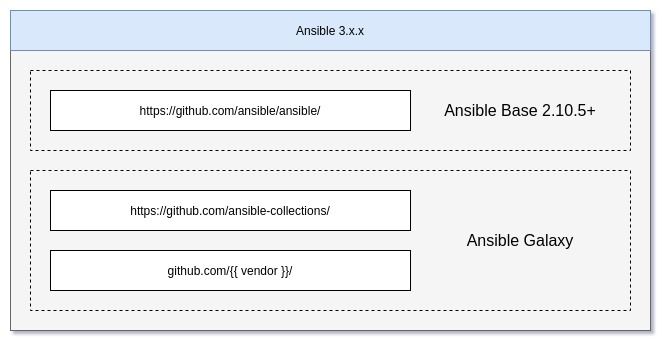Ansible Runner Python Example
Topics
- Ansible Runner Python Example Pdf
- Ansible Runner Python Examples
- Ansible Python Api Example
- Python Tutorial
- Python API
- Python API pre 2.0
Please note that while we make this API available it is not intended for direct consumption, it is herefor the support of the Ansible command line tools. We try not to make breaking changes but we reserve theright to do so at any time if it makes sense for the Ansible toolset.
This is a task runner that serves as a higher-level automation layer to ansible. The script expects an ansible-playbook file as the task manifest. By default, this is a file named 'Taskfile.yaml' in the current working directory. The inspiration for the tool comes from the gnu make command, which operates in similar fashion, i.e. This project wraps the ansiblerunner interface inside a REST API enabling ansible playbooks to be executed and queried from other platforms. The incentive for this is two-fold; provide Ansible integration to non-python projects. Provide a means of programmatically running playbooks where the ansible engine is running on.
The following documentation is provided for those that still want to use the API directly, but be mindful this is not something the Ansible team supports.
The following are 13 code examples for showing how to use ansible.executor.playbookexecutor.PlaybookExecutor.These examples are extracted from open source projects. You can vote up the ones you like or vote down the ones you don't like, and go to the original project or source file by following the links above each example. Apr 13, 2016 I have an ansible server that I find works fine, but when I try to run a python script on the deployed servers I get no such file or directory, even though I visually confirm they are there.
Examples of this could include: Sending status to Ansible Tower/AWX Sending events to an external logging service.
There are several interesting ways to use Ansible from an API perspective. You can usethe Ansible python API to control nodes, you can extend Ansible to respond to various python events, you canwrite various plugins, and you can plug in inventory data from external data sources. This documentcovers the execution and Playbook API at a basic level.
If you are looking to use Ansible programmatically from something other than Python, trigger events asynchronously,or have access control and logging demands, take a look at Ansible Toweras it has a very nice REST API that provides all of these things at a higher level.
Ansible is written in its own API so you have a considerable amount of power across the board.This chapter discusses the Python API.

The Python API is very powerful, and is how the all the ansible CLI tools are implemented.In version 2.0 the core ansible got rewritten and the API was mostly rewritten.
注解
Ansible relies on forking processes, as such the API is not thread safe.
In 2.0 things get a bit more complicated to start, but you end up with much more discrete and readable classes:
It’s pretty simple:

The run method returns results per host, grouped by whether theycould be contacted or not. Return types are module specific, asexpressed in the About Modules documentation.:
A module can return any type of JSON data it wants, so Ansible canbe used as a framework to rapidly build powerful applications and scripts.
The following script prints out the uptime information for all hosts:
Advanced programmers may also wish to read the source to ansible itself,for it uses the API (with all available options) to implement the ansiblecommand line tools (lib/ansible/cli/).
参见
- Developing Dynamic Inventory Sources
- Developing dynamic inventory integrations
- Developing Modules
- How to develop modules
- Developing Plugins
- How to develop plugins
- Development Mailing List
- Mailing list for development topics
- irc.freenode.net
- #ansible IRC chat channel
What are cron jobs?

In many UNIX/LINUX type operating systems, the Cron is one of the very valuable and productive utility. It is used to run commands and scripts at pre-defined time.
These pre-scheduled jobs are called 'cron jobs'.
Some Common Cron Jobs Use Cases
- Deleting Old/Unused Files
- Regular Checking of Disk Space
- Regular Pre-Scheduled Backups
- Operating System Maintenance Jobs
- etc.
How to create a simple cron job? (Without Ansible)
Run the follwoing command at linux shell prompt:
- linux-prompt$ crontab -l # To list the crontab enteries
- linux-prompt$ crontab -e # To edit/add crontab enteries
Following is the syntax of cron job entry in the crontab file:
For Example:
- To run /path/command ten minutes every day, after midnight, following will be the entry:
10 0 * * * /path/command
- To run /path/myscript.sh at 3:30 PM on the fifth day of every month, following will be the entry:
30 15 5 * * /path/myscript.sh
- To run /path/myscript.sh at 6 PM on selected working weekdays (Monday, Tuesday and Wednesday), following will be the entry:
0 18 * * 1-3 /path/myscript.sh
How Ansible is useful to manage cron jobs?
The Ansible cron module is used to manage the crontab entries via play books. Consider, If you have many servers and you want to configure some common cron jobs on all servers, then configuring the same job manually on all servers will be tedious and error-prone task. Ansible can do this job via a simple playbook to configure the said cron jobs on all servers automatically (in one go).
Step by Step Example of using Ansible CRON module
Ansible Runner Python Example Pdf
Pre-Requisites:
1- One Ansible Control Node
2- Two Ansible managed hosts (You may use as many as you want)
3- Network access between control node and managed nodes
Ansible Runner Python Examples
4- Host names of all three nodes should be registered with DNS server or appropriate entries should be present in the /etc/hosts files (on all three nodes).
5- User SSH keys should have already been generated at control node and shared with managed nodes (see this article to configure SSH Keys: http://tiny.cc/ro75fz

Note: In this article, we have used one user 'fakhar' on all three nodes. Its SSH keys have been generated at control node and shared on both managed hosts.
Step-1: Create an inventory file at control node (i.e. CentOS-Ctrl-Node), containing the host names of both managed servers, as shown in below image:
Step-2: Create an ansible playbook, to schedule cron jobs as shown below:
Step-3 (Optional): Run the 'tree' command at control node, where your playbook is placed (this is just to show you as how the files are placed/organized). See image below:
Ansible Python Api Example
Step-4: Run the 'crontab -l' and 'ls -l /home/fakhar/temp.txt' on both managed hosts to confirm the status before the execution of playbook. See image below:
Step-5: Run the playbook using command 'ansible-playbook -i inventory cronPlayBook.yml' at control node. See image below. The playbook has been executed successfully.
Step-6: Check the result on the target managed hosts after the cron job scheduled time. For this purpose, run the 'crontab -l' and 'ls -l /home/fakhar/temp/txt' commands on both managed hosts. See image below, the cron job entries have been created and executed at specified time. The cron jobs have collected the system information and placed it in the target file (i.e. /home/fakhar/temp.txt) successfully.
Python Tutorial
Thank you.